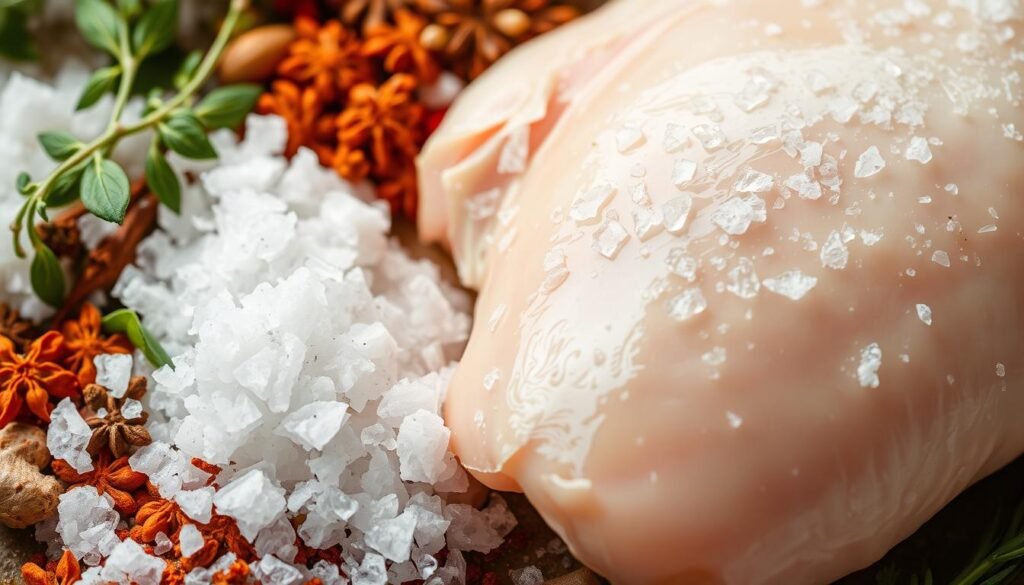Learn how to brine chicken breasts for juicy, flavorful results every time. Discover the perfect brining solution and timing to elevate your chicken dishes to restaurant quality
Getting your chicken breasts just right can be tricky. But, the secret is brining. This method makes your chicken juicy and full of flavor. It’s perfect for grilling, baking, or sautéing.
Brining your chicken before cooking is a big improvement. It helps keep the meat juicy and enhances its flavor. By soaking the chicken in a salt-water mix, you get a dish that’s both tender and flavorful. This guide will teach you the basics of brining, what ingredients to use, and how to do it right.
Understanding the Science Behind Chicken Brining
Brining is essential for ensuring that chicken breasts remain juicy and packed with flavor. Let’s delve into the science behind this straightforward technique.
Osmosis and Salt Concentration
Osmosis is the base of brining. When chicken is in a saltwater solution, the salt outside is more concentrated. This difference makes water move from inside the chicken to the brine. This keeps the chicken moist and tender, even after it’s cooked.
Protein Structure Changes
Brining also changes the chicken’s protein structure. The salt in the brine breaks down the proteins’ tight bonds. This makes the meat tender and keeps it moist during cooking, so it doesn’t dry out.
Moisture Retention Mechanics
- The increased moisture in the meat from osmosis keeps it juicy.
- The changed protein structure stops moisture from being squeezed out during cooking.
- This mix of factors makes your brined chicken breasts tender and moist, even when cooked well.
Knowing the food science of brining is crucial for juicy and tasty chicken breasts. By using osmosis, salt concentration, protein denaturation, and moisture retention, you can make your chicken dishes outstanding.
Essential Ingredients for Perfect Chicken Brine
Making a tasty chicken brine needs the right ingredients. You’ll need different salt types and aromatic herbs and spices. Each one is important for flavor and texture. Let’s look at the key elements for a great brine.
Salt: The Foundation of Brine
The base of a good chicken brine is the salt used. Table salt works, but try kosher, sea, or pink Himalayan salt too. Each has its own taste and minerals that change the flavor.
Sweeteners: Adding a Touch of Balance
Adding a bit of sugar or honey can balance the brine. It makes the flavor more rounded. This sweetness also helps the chicken brown nicely during cooking.
Aromatics: Infusing Flavor
Make your brine better with aromatics like garlic, onions, bay leaves, or citrus peels. They add a rich flavor that goes beyond salt and sugar.
Herbs and Spices: Customizing the Flavors
Try different herbs and spices to make your brine unique. Use rosemary, thyme, peppercorns, and paprika. The goal is to find a mix that complements the chicken’s natural taste.
| Ingredient | Purpose | Examples |
|---|---|---|
| Salt types | Establish the foundation of the brine | Kosher salt, sea salt, pink Himalayan salt |
| Sugar | Balance the saltiness and aid in caramelization | Granulated sugar, honey, brown sugar |
| Aromatics | Infuse the brine with complex flavors | Garlic, onions, bay leaves, citrus peels |
| Herbs and spices | Customize the flavor profile | Rosemary, thyme, peppercorns, paprika |
Choosing and mixing these brine ingredients carefully will open up a world of flavors. Your chicken breasts will become a culinary masterpiece. Get ready to wow your taste buds and make your next meal unforgettable!
Basic Wet Brine Recipe for Chicken Breasts
Brining chicken breasts is a simple way to add flavor and juiciness. The secret is finding the right mix of salt, water, and optional aromatics. Follow this basic wet brine recipe to make your chicken breasts a culinary delight.
Salt-to-Water Ratio Guidelines
The key to a good wet brine is the salt-to-water ratio. Aim for 1/4 cup of salt for every 1 cup of water. This ratio helps the brine soak into the chicken, keeping it moist and flavorful.
Optional Aromatics and Seasonings
- To boost the flavor, add aromatic ingredients like:
- Fresh herbs (rosemary, thyme, sage, etc.)
- Whole spices (peppercorns, bay leaves, coriander seeds, etc.)
- Citrus zest (lemon, orange, or lime)
- Garlic cloves
- Onion slices
Storage Container Requirements
Choose a non-reactive container for brining chicken breasts. Use food-grade plastic, glass, or stainless steel. Stay away from aluminum or reactive materials to avoid a metallic taste. Make sure the container is big enough to cover the chicken in brine.
| Ingredient | Quantity |
|---|---|
| Water | 1 cup |
| Salt | 1/4 cup |
| Rosemary (fresh, whole) | 2 sprigs |
| Lemon zest | 1 tablespoon |
| Garlic cloves | 2 cloves, peeled |

How to Brine Chicken Breasts Step by Step
Brining chicken breasts is a simple yet transformative process. It enhances the flavor and juiciness of your poultry. By following a step-by-step guide, you can unlock the full potential of the brining process. Enjoy succulent, flavorful chicken every time.
First, prepare the brine immersion solution. In a large container, combine the necessary salt-to-water ratio, along with any desired aromatics or seasonings. Stir the mixture until the salt has fully dissolved, creating a homogeneous brine.
- Gently lower the chicken preparation into the brine, ensuring the breasts are fully submerged.
- Cover the container and refrigerate the chicken for the recommended brining duration, typically between 30 minutes to 2 hours, depending on the thickness of the breasts.
- Periodically check the chicken, ensuring the brine remains at a consistent temperature and the breasts stay submerged throughout the step-by-step guide.
Once the brining time has elapsed, remove the chicken from the brine and rinse it under cool water. Pat the breasts dry with paper towels, removing any excess moisture before cooking.
| Chicken Breast Size | Recommended Brining Time |
|---|---|
| 4-6 oz | 30-45 minutes |
| 6-8 oz | 45-60 minutes |
| 8-10 oz | 60-120 minutes |
By following this step-by-step guide, you’ll achieve perfectly brined chicken breasts. They are juicy, flavorful, and ready to be transformed into a variety of delicious dishes.
Optimal Brining Times and Temperature Control
Brining chicken breasts is all about the right time and temperature. The size of your chicken breasts is key to getting it just right. This ensures your meat is seasoned well and stays juicy.
Recommended Duration for Different Breast Sizes
- For small chicken breasts (4-6 oz), aim to brine for 2-4 hours.
- Medium-sized breasts (6-8 oz) should be brined for 4-6 hours.
- Larger chicken breasts (8-12 oz) will benefit from a 6-8 hour brining duration.
It’s important to keep an eye on the temperature control while brining. Keep the brine at a steady temperature between 35°F and 40°F (1.7°C and 4.4°C). This helps keep your food safe and moist.
| Chicken Breast Size | Recommended Brining Duration | Ideal Temperature Range |
|---|---|---|
| Small (4-6 oz) | 2-4 hours | 35°F – 40°F (1.7°C – 4.4°C) |
| Medium (6-8 oz) | 4-6 hours | 35°F – 40°F (1.7°C – 4.4°C) |
| Large (8-12 oz) | 6-8 hours | 35°F – 40°F (1.7°C – 4.4°C) |
Knowing the brining duration for different chicken breast sizes and keeping the right temperature control is key. This will help you make deliciously moist and flavorful brined chicken every time.
Common Brining Mistakes to Avoid
Brining chicken breasts can make them taste better and stay juicy. But, you must avoid common mistakes. These include over-brining, under-brining, and brine contamination. These errors can make your chicken dry, tasteless, or even unsafe. Don’t worry, with some knowledge, you can avoid these problems and get delicious chicken every time.
Avoiding Over-Brining
One big mistake is brining chicken too long. Longer brining can add more flavor, but too long makes it salty and mushy. Always follow the brining time based on your chicken’s size and the recipe you’re using.
Preventing Under-Brining
Not brining chicken enough is another mistake. This makes it taste bland and dry. To avoid this, use a timer and follow the recommended brining times for your recipe and chicken size.
Maintaining Brine Cleanliness
Another mistake is brine contamination. This happens if the brine is not clean or if the chicken isn’t rinsed well before cooking. Bacteria can grow in dirty brine, which is unsafe. Always use clean containers for brining and rinse your chicken well before cooking.
By watching out for these common mistakes, you can make sure your chicken is juicy, flavorful, and cooked just right. With a bit of practice and attention to detail, you’ll get better at brining for amazing taste.
Dry Brining Alternatives for Chicken Breasts
Wet brining is a favorite for adding flavor and moisture to chicken breasts. But, there’s another method to try – dry brining. This method involves rubbing chicken with salt, letting it absorb the flavor through osmosis.
Salt Measurements for Dry Brining
Getting the right amount of salt is crucial for dry brining. Use about 1/2 teaspoon of salt for each pound of chicken. Spread the salt all over the chicken breasts. This salt rub will make the meat juicier and more flavorful.
Technique Comparison with Wet Brining
Dry brining has its perks over wet brining. It’s simpler and quicker, needing fewer ingredients. It also prevents over-salting, a common issue with wet brines. Dry brining lets you control the salt measurements for a balanced taste.
Both wet and dry brining can make chicken breasts taste better. Try them both to see which one you prefer. It’s all about finding what works for you.
Flavor Enhancement: Herbs and Spices in Your Brine
Adding more than just salt and water to your chicken brine can make a big difference. By using herbs, spices, and other aromatic ingredients, you can create many flavor profiles. This lets you explore the amazing effects of herb infusion and spice blends on your chicken.
Fresh herbs like rosemary, thyme, sage, and oregano add a savory taste to your chicken. For a bit of brightness, try adding lemon or orange zest. Or, use spices like cumin, chili powder, or smoked paprika for a bolder flavor.
| Herb or Spice | Flavor Notes | Suggested Pairings |
|---|---|---|
| Rosemary | Earthy, piney | Chicken, lemon, garlic |
| Thyme | Herbaceous, slightly minty | Chicken, white wine, onion |
| Garlic | Pungent, savory | Chicken, herbs, citrus |
| Cumin | Warm, earthy | Chicken, chili, lime |
| Smoked Paprika | Smoky, slightly sweet | Chicken, tomato, bell pepper |
Try mixing different herb infusion and spice blend combinations. This way, you can find the flavor profiles that you like best. With a bit of creativity, you can turn a simple chicken breast into a delicious, flavorful dish.
Post-Brining Preparation Techniques
After brining your chicken breasts, it’s key to prepare them well for cooking. This guide will show you how to get your brined chicken ready for a tasty meal.
Proper Rinsing Methods
To avoid salty chicken, rinse it well after brining. Here’s how to rinsing brined chicken:
- Put the brined chicken breasts under cold running water. Make sure all sides are rinsed.
- Massage the chicken gently with your fingers. This helps water get in and wash out salt.
- Pat the chicken dry with paper towels or a clean towel. Be gentle to avoid damaging the meat.
Drying Techniques
Right drying is crucial for a crispy chicken exterior. Try these drying methods:
- Put the rinsed chicken on a wire rack over a baking sheet. This lets air get to the meat.
- Use paper towels to dry the chicken. Press gently to soak up moisture.
- Put the chicken in the fridge for 30 minutes to 1 hour. This helps it dry more before cooking preparation.
By following these post-brine preparation steps, your brined chicken will be perfectly seasoned. It’s ready for a delicious, flavorful meal.
Cooking Methods for Brined Chicken Breasts
Brining chicken breasts before cooking makes them taste better and stay juicy. You need to pick the right cooking method for the best results. Let’s look at the best ways to cook brined chicken.
Grilling Brined Chicken Breasts
Grilling is a great choice for brined chicken breasts. The salt in the brine keeps the meat moist, even when it’s hot. Use medium-high heat and check the chicken’s temperature often, as it cooks faster.
Roasting Brined Chicken Breasts
Roasting is also a good option for brined chicken breasts. The brine keeps the meat juicy, while the oven’s heat makes the outside crispy. Roast at 375°F (190°C) until the chicken reaches 165°F (74°C).
Pan-Searing Brined Chicken Breasts
Pan-searing is quick and easy for brined chicken breasts. The brine keeps the meat moist, and the sear makes it golden. Use a big skillet and watch the chicken’s temperature.
Sous Vide Brined Chicken Breasts
Sous vide is perfect for cooking brined chicken breasts. It keeps the meat juicy and flavorful. Cook at 140-145°F (60-63°C) for 1-2 hours, then sear it fast for a crispy outside.
Brined chicken breasts are always a hit, no matter how you cook them. Try different methods to find your favorite.
| Cooking Method | Temperature | Cooking Time | Tips |
|---|---|---|---|
| Grilling | Medium-high heat | 12-15 minutes | Monitor internal temperature closely |
| Roasting | 375°F (190°C) | 20-25 minutes | Adjust oven temperature as needed |
| Pan-Searing | High heat | 6-8 minutes per side | Use a large skillet or sauté pan |
| Sous Vide | 140-145°F (60-63°C) | 1-2 hours | Finish with a quick sear |
Storage Tips for Brined Chicken
Storing brined chicken right is key to keeping it tasty and safe. Knowing how to refrigerate or freeze it can greatly improve its flavor and texture.
Refrigeration Guidelines
Brined chicken stays good in the fridge for up to 4 days after brining. Always use an airtight container or sealed bag to keep moisture in and bacteria out. Keeping the fridge at 40°F (4°C) or lower is vital for safety and to stop bacteria from growing.
Freezing Recommendations
To store it longer, freeze brined chicken for up to 3 months. Wrap it tightly in plastic or put it in a freezer bag, squeezing out air. This stops freezer burn and keeps the meat quality high. Always thaw frozen chicken in the fridge, not at room temperature, for safety.
By sticking to these brined chicken storage tips, you can enjoy your delicious chicken for weeks. You’ll also keep it food safe and of high quality, whether it’s in the refrigerator or freezer.
Health Considerations and Sodium Content
When you start brining chicken breasts, think about the health effects, especially the sodium. Brining makes your chicken taste better and feel juicier. But, it uses salt, which means more sodium.
If you’re watching your sodium, pay close attention to the salt in brining. Eating too much sodium may lead to hypertension as well as heart disease and kidney issues.
For a healthier option, try low-sodium brining. You can use less salt or add other seasonings. This way, you can still enjoy brining without overdoing it on the sodium. Also, watch your sodium intake in all meals and control your portion sizes for a healthier life.
| Brining Approach | Sodium Content | Health Impact |
|---|---|---|
| Traditional Brining | Typically high in sodium | May contribute to increased risk of health issues for those with sodium-related concerns |
| Low-Sodium Brining | Significantly reduced sodium levels | Suitable for individuals monitoring their sodium intake and maintaining a balanced diet |
Knowing about health and trying low-sodium brines lets you enjoy brining safely. It’s all about finding a balance for your health.

Troubleshooting Common Brining Issues
Brining chicken breasts is a great way to boost flavor and texture. But sometimes, you might run into problems. Don’t worry, we’re here to help you fix common brining issues and get the best results.
Texture Problems and Solutions
Maybe your brined chicken breasts feel tough or dry. This could be because you brined them too long or didn’t control the temperature right. To fix this, follow the recommended brining time for your chicken size and keep the temperature safe.
Also, make sure to rinse and dry the chicken well before cooking. This can greatly improve its texture.
Flavor Balance Adjustments
If your chicken tastes too salty or unbalanced, you can tweak the brine. Try reducing the salt or adding more herbs, spices, or citrus. The goal is to find a flavor that perfectly complements your chicken.
FAQ
What is the purpose of brining chicken breasts?
Most people love to prepare their chicken breast through brining as it makes the meat to be so delicious and juicy. It includes an immersion process of the chicken in a saltwater mix. This allows the meat soak up the flavors and water, it becomes tender and flavourful.
What are the key ingredients needed for a chicken brine?
You’ll need salt, water, and sometimes herbs, spices, and sweeteners for a basic brine. You can use kosher or sea salt. Adding brown sugar, honey, or citrus can also enhance the taste.
How long should you brine chicken breasts?
Brining time varies by breast size. Smaller breasts need 30-60 minutes, while bigger ones might take up to 4 hours. This lets them fully absorb the brine.
What is the right salt-to-water ratio for chicken brine recipe ?
Use 1/4 cup of salt for every 1 cup of water. You can modify this ratio to match your personal taste preferences.
How should you store the brined chicken breasts?
After brining, rinse and pat dry the chicken. Keep it in a sealed container in the refrigerator for 3 to 5 days. You can also freeze it for longer storage.
Can you dry brine chicken breasts instead of using a wet brine?
Yes, you can dry brine chicken. Rub a salt mix on the meat and refrigerate it for a similar time as wet brining.
what are the most common mistakes to avoid when brining chicken?
When brining chicken there is potential of over-brining and have the chicken turn very salty or mushy or under doing it and it will not be salty or moist enough. Also, don’t under-brine, as it won’t enhance flavor and moisture. The brine you apply to the chicken must be appropriately salted and cool when it is time to soak the chicken in it . After preparation make sure that the chicken spends just the right amount of time in the brine then rinse off excess salt before cooking.
How does brining affect the cooking process for chicken breasts?
Brining can change how chicken cooks. It may cook faster due to increased moisture. Always check the internal temperature to prevent overcooking.
Can you flavor a chicken brine with herbs and spices?
Yes, adding herbs, spices, and aromatics can make the brine more flavorful. Try garlic, onion, peppercorns, bay leaves, thyme, rosemary, and citrus zest for unique tastes.
How does brining affect the sodium content in chicken breasts?
Brining increases the sodium in chicken breasts because the meat absorbs salt. If you’re watching your sodium, use low-sodium brines or try dry brining instead.
High intake of sodium is dangerous to our health since it leads to high blood pressure, heart diseases, and stoke. They may include high blood pressure that raises the risk of potential health complications and effects the heart and arteries. If you are interested in living a new lifestyle, then it would be helpful to look at a heart-healthy diet. The websites of such organizations as the American Heart Association, the CDC’s Heart Disease Resources contain useful information concerning the proper sodium consumption and ways to support heart health.






